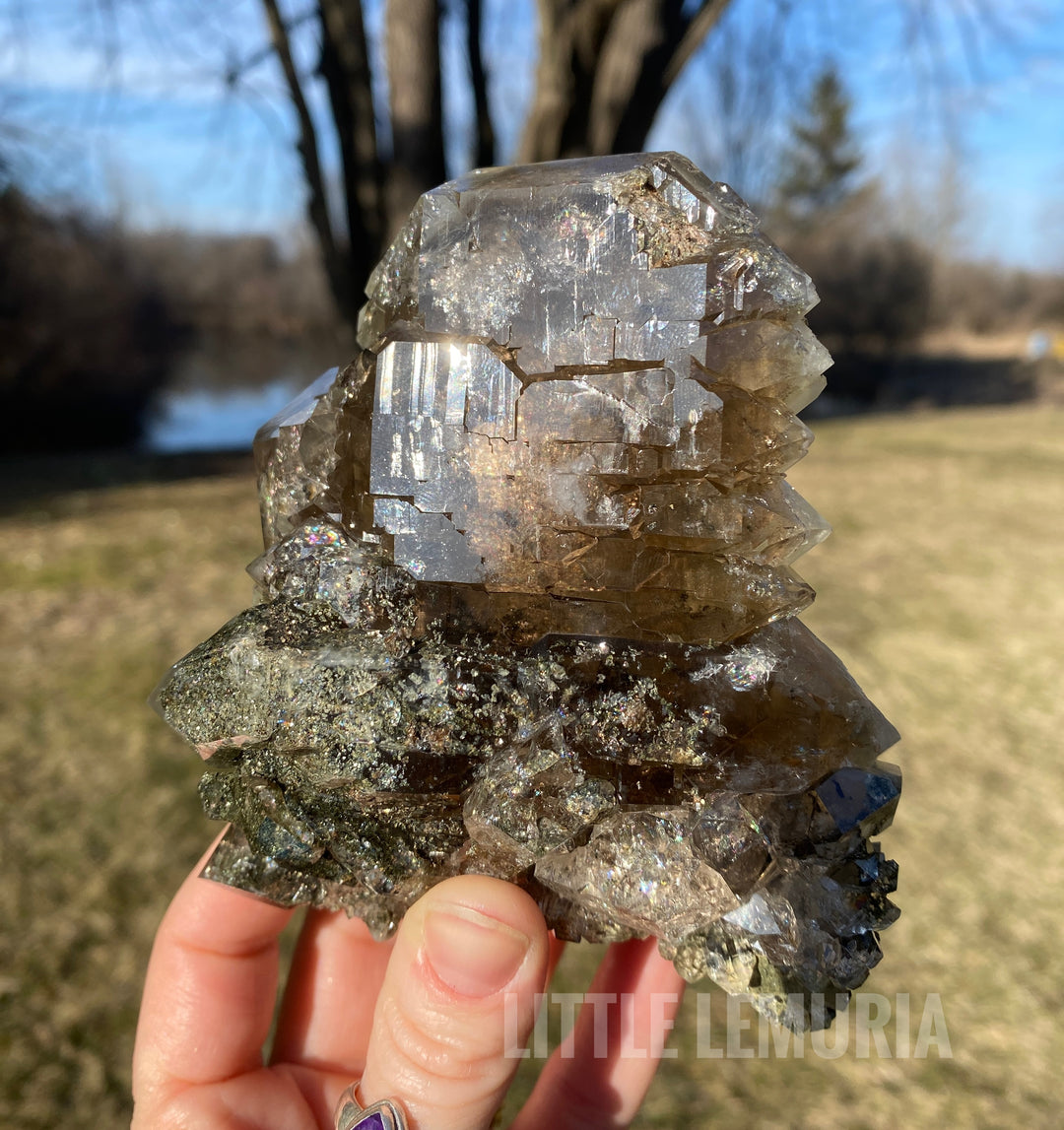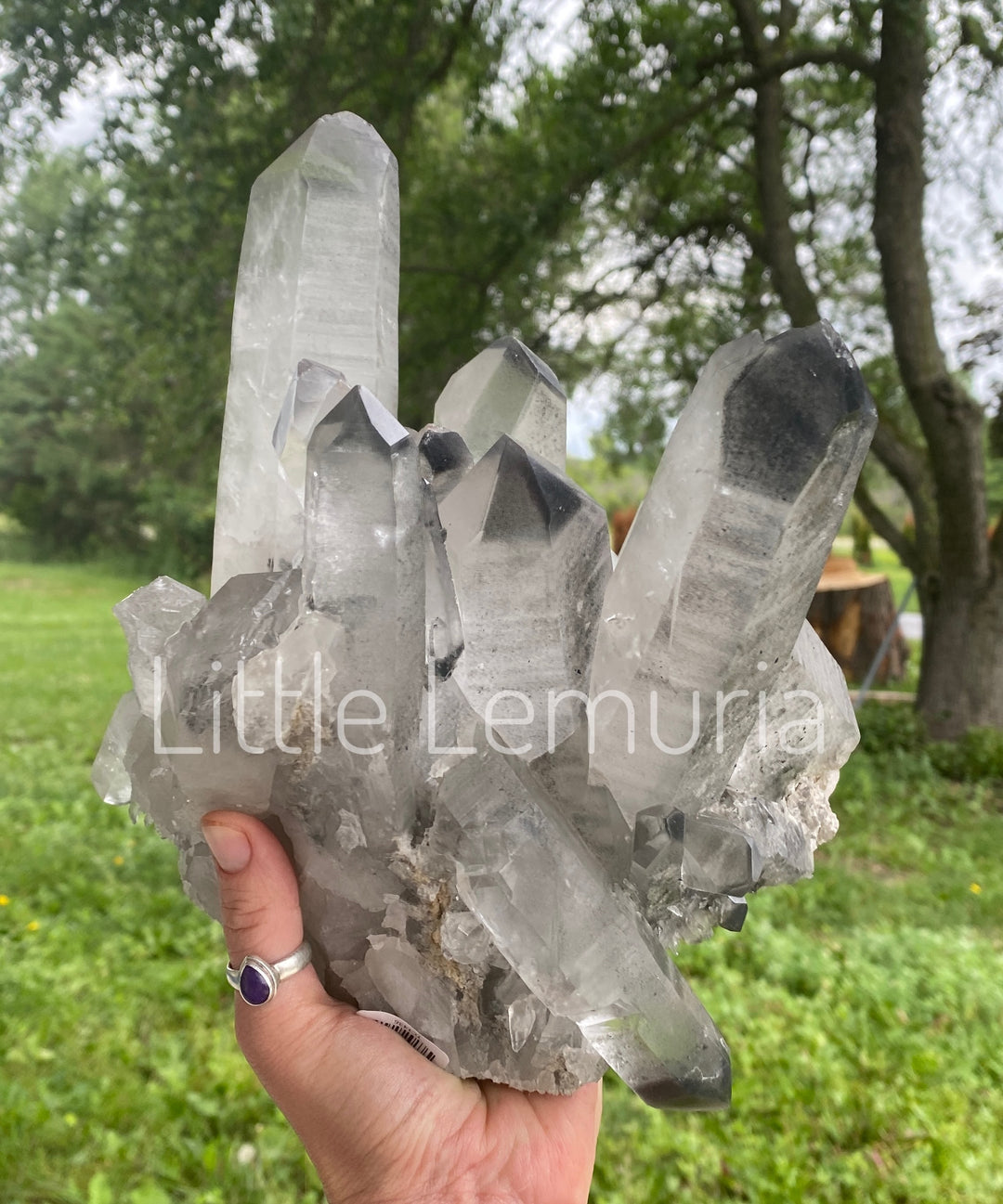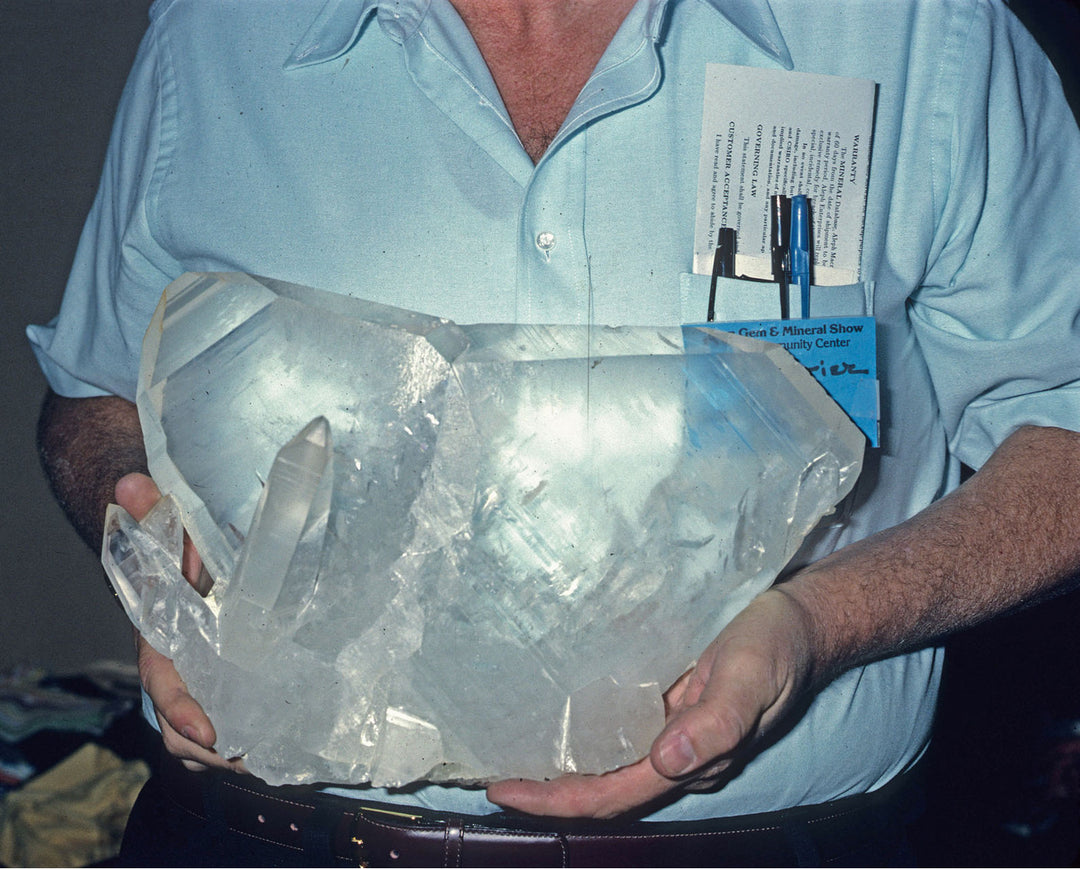Geologic Variations Between ‘Herkimer Diamond’ Quartz Crystals and ‘Pakimer’ Quartz Crystals By: Northern Maine Minerals
Geologic Variations Between ‘Herkimer Diamond’ Quartz Crystals and ‘Pakimer’ Quartz Crystals By: Northern Maine Minerals
QUESTION: What Makes Herkimer Diamond Quartz Crystals More Unique than Other Quartz Crystals?
GENERAL BACKGROUND STATEMENTS:
- Silica is one of the most common elements in the Earth. - Silica Dioxide (Si02) is the chemical formula of pure quartz - Quartz crystals can form under a variety of conditions forming intrusions into their host rock. - Host rock is the term used for the rock that was originally there before it became intruded. - Intrusions are separations in the host rock filled by a different rock. - Quartz is a component of granite and other igneous rocks. - Quartz can also be a component of metamorphic rocks which form as a result of heat and pressure. - Quartz can form under a variety of conditions all governed by temperature and pressure. - “Herkimers” – term used to describe quartz crystals formed near Herkimer, NY. - “Pakimers” – term used to describe quartz crystal formed in the country of Pakistan.
HERKIMER DIAMOND QUARTZ vs. PAKIMER OIL QUARTZ As the popularity and rarity of Herkimer Diamond Quartz Crystals has grown, so too has the demand for crystals with similar characteristics. One of the largest producers of Herkimer Diamond-like Quartz Crystals is the country of Pakistan. Affectionately referred to as Pakimers, these crystals have flooded the market and essentially devalued the rarity of the authentic Herkimer Diamond Quartz Crystal.
As a geologist and miner of Herkimer Diamonds, this is both disturbing and deceitful on many levels. Pakimers, although they look similar to Herkimers, are most definitely not Herkimer Diamond Quartz crystals, for two very important reasons.
- Pakimers are not rare.
The quartz crystals formed in Pakistan form in a number of different locations within the entire country. The quartz that forms is a product of temperature, pressure and intrusions impacting the host rock. The quartz crystals formed near Herkimer, NY are isolated to a fault-bound block of host rock with a very limited geographic extent of only a few tens of miles.
- Pakimers form under different geologic conditions.
The quartz crystals formed in Pakistan form as a result of several factors working together. First, the quartz sandstone was deposited from sediments with land-based origins. As nearby mountains continued to grow, this sandstone became buried to a depth of approximately 3km to 4km, and the quartz rich sand grains began to warm. At 3-4km depth, nearby oil and gas formations beneath the sandstone mixed with acidic groundwater. This process began to cause the warmed sandstone sand grains to dissolve and reform. The quartz sand grains reformed as quartz crystals, and other minerals reform as well, including feldpsar. This is one way for oil and gas reservoirs to form in terrestrial-derived sandstones due to the other chemical changes that occur with minerals also found in the sand grains (ilite formation from feldspar content in the host rock). Some of the oil and water that is trapped in these reservoirs is included in the quartz crystals.
- Herkimers grow as a result of very different geologic conditions.
Herkimer Diamond Quartz Crystals have formed under a much more involved set of processes over a much longer period of geologic time. First, the host rock was a marine sediment deposited over 1 billion years ago as part of the splitting of supercontinent Rodinia. This included the development of shallow marine pools where ancient algae called Stromatolites formed extensive mats. The finer marine sediments find their origins in the microscopic marine life found at that time – namely foraminifera (forams) and diatoms. As these microscopic organisms died, their shells were deposited as mud. The shells of the forams were made of pure silica.
The Herkimer deposit was buried at various depths during different mountain building events spanning over 1.1 billion years of time. The ancient marine deposits were buried to depths greater than 3km during mountain building events 0.9 to 0.75 billion years; then again during a secondary mountain building event forming the Adirondack Mountains at about 0.5 billion years ago. At this time the segment of rock holding the Little Falls Dolostone (Herkimer Diamond Quartz Crystal host rock) broke free from its main body (see Adirondack Mountains and Grenville Orogeny) essentially creating a free-floating island of rock bounded on all sides by faults. This faulting limits the geographic extent Herkimer Diamond Quartz Crystals can be found.
Over the course of 1.1 Billion Years, this body of free-floating marine-based rock (including a rock body known as the Little Falls Dolostone), became heated and cooled at least three different times at depths of at least 3km, the different sediments deposited by the marine organisms began to heat and dissolve as the rock transformed from limestone to dolomite. Deep seeded sea water mixed with the dissolving elements in the limestone at depth formed an acidic environment needed to form Herkimer Diamond Quartz Crystals.
- Why do Herkimer Diamonds form in shapes other than perfect double terminated crystals?
The crystalline quartz forming Herkimer Diamond Quartz Crystals originated as an acidic fluid which dissolved cavities in limestone as it metamorphosed into dolomite. Because of this unique geologic setting, there are crystals that grow attached to the host rock. This is especially true along the remains of the stromatolite beds where very large cavities have opened up in the rock. Below the stromatolite beds, the quartz crystals form in very small pockets usually no bigger than a golf ball.
At the stromatolite layer and above, there is a higher concentration of larger crystals that grow attached to the pocket walls. These are usually accompanied by free-floating crystals inside the void spaces of the pocket. It is at the stromatolite bed layer that the highest concentration of skeletal crystals are found. Skeletal crystals are typically attached to the walls of the pocket, and therefore often appear with a component of the host rock still attached to one side.
The ‘Jewelry Stone Layer’ is the zone below the stromatolite beds. This zone has experienced repeated episodes of the greatest amount of heat over the longest period of time. As a result, the quartz and other minerals present have been separated into their constituent parts. This zone is referred to as the ‘Jewelry Stone Layer’ and is where 90% of the water-clear double terminated Herkimer Diamond Quartz Crystals come from. This layer is where most people collect crystals from, and likely the original source of the Herkimer Diamond name for these crystals. See Diagram below.

SUMMARY: Even though quartz crystals from Pakistan appear to be similar to the crystals from Herkimer, NY USA, there are striking differences. First, Pakimers form from buried land-based sediments that are heated and intruded by fresh water mixing with hydrocarbons forming from rock units below the sandstone. Second, Pakimers are found over a much larger geographic area making them easier to mine and sell in large quantities. Third, Pakimers are much younger than the Herkimer Diamond Quartz Crystal (less than 100 million years old).
This is strikingly different from Herkimer Diamond quartz crystals which, first, form from marine-based (not land-based) sediments that are heated and intruded by seawater (not fresh water). Second, the liberation of hydrocarbons found in the Little Falls dolomite likely originates from the organic matter found within the marine sediments (not from an underlying rock body like Pakimers). Third, the body of marine sediment (Little Falls Dolomite) has undergone repeated events of heating and cooling over a much longer period of geologic time (500 million to 1.1 billion years). And fourth, the geographic extent of the Herkimer Diamond bearing rock is only a few tens of miles as opposed to the existence of Pakimers over the expanse of an entire mountain range across the country.
REFERENCES:
- Chiarenzelli, J. R.; Selleck, B.W.; Geology of the Adirondack Mountains. Adirondack Journal of Environmental Studies, Volume 21, October 2016
- Zenger, D.H.; Definition of Type Little Falls Dolostone (Late Cambrian) East-Central New York; The American Association of Petroleum Geologists, 1976.
- Bilgrami, S.A. Pakistan Chrome Mines Limited, Hindubagh, West Pakistan. Geology and Chemical Mineralogy of the Zhob Valley Chromite Deposits, West Pakistan.
- Qasim, M.; Quartz with Oil Inclusions from Zhob, Balochistan, Pakistan; Geologylearn.blogspot.com/home/petroleum/reservoir/oil inclusions in quartz cement, sandstone reservoir
- Krone, F.J., Geologist. Field Observations of Herkimer Diamond Quartz Crystal Formation
ADDITIONAL INFORMATION:
METAPHYSICAL PROPERTIES:
Why are the metaphysical properties of Quartz Crystals from Pakistan different than Quartz Crystals from the Herkimer region of New York State, USA?
Crystals each have their own energies. These energies are influenced by the type of crystal (i.e. quartz vs. tourmaline), the energies of their environment, and the energies of their possessors. Herkimer Diamond quartz crystals begin their formation from ancient life that existed in our oceans over a billion years ago. The energy of this ancient life has been captured in the host rock, and especially, the crystals. Every inclusion within the quartz crystals from Herkimer also are derived from ancient living marine organisms. This includes life energy from the microscopic foraminifera all the way to the energies of the large stromatolite algae mats. This rock formed from a living environment over a very long period of time (10x longer formation time than Pakimers).
Pakimer quartz crystal formation derives from inorganic land sediments that were carried down into a basin by streams and rivers. The origins of the organic hydrocarbon compounds that mix with the fresh water to create the environment necessary for Pakimer formation come from different bodies of rock under the sandstone layer. The result is a quartz crystal that looks like a Herkimer Diamond Quartz Crystal, but with a completely different energy. These crystals are formed from a non-living environment over a shorter period of time.
About the Author: Northern Maine Minerals has been mining Herkimer Diamond Quartz Crystals for over 25 years. During this time, Fred, our Geologist, has taken detailed notes and observations on the formation of Herkimer Diamond Quartz Crystals. This paper uses published independent scientific observations, some from peer-reviewed journals, in combination with Fred’s field observations over his 25 years of experience extracting Herkimer Diamond Quartz Crystals from the Little Falls Dolostone in and around Middleville, Herkimer County, New York.
All photos and content contained in this document belong to Northern Maine Minerals and are used with permission.
© 2020 Northern Maine Minerals all rights reserved.
Read more about Fred Krone and Northern Maine Minerals HERE
If you'd like to learn more about Rodinia check out the PBS special "The Whole Saga of Supercontinents" HERE









